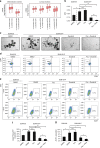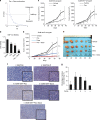Dasatinib sensitises triple negative breast cancer cells to chemotherapy by targeting breast cancer stem cells
- PMID: 30482914
- PMCID: PMC6288167
- DOI: 10.1038/s41416-018-0287-3
Dasatinib sensitises triple negative breast cancer cells to chemotherapy by targeting breast cancer stem cells
Abstract
Background: Patients with triple negative breast cancer (TNBC) exhibit poor prognosis and are at high risk of tumour relapse, due to the resistance to chemotherapy. These aggressive phenotypes are in part attributed to the presence of breast cancer stem cells (BCSCs). Therefore, targeting BCSCs is a priority to overcoming chemotherapy failure in TNBCs.
Methods: We generated paclitaxel (pac)-resistant TNBC cells which displayed higher sphere forming potential and percentage of BCSC subpopulations compared to the parental cells. A screen with various kinase inhibitors revealed dasatinib, a Src kinase family inhibitor, as a potent suppressor of BCSC expansion/sphere formation in pac-resistant TNBC cells.
Results: We found dasatinib to block pac-induced BCSC enrichment and Src activation in both parental and pac-resistant TNBC cells. Interestingly, dasatinib induced an epithelial differentiation of the pac-resistant mesenchymal cells, resulting in their enhanced sensitivity to paclitaxel. The combination treatment of dasatinib and paclitaxel not only decreased the BCSCs numbers and their sphere forming capacity but also synergistically reduced cell viability of pac-resistant cells. Preclinical models of breast cancer further demonstrated the efficiency of the dasatinib/paclitaxel combination treatment in inhibiting tumour growth.
Conclusions: Dasatinib is a promising anti-BCSC drug that could be used in combination with paclitaxel to overcome chemoresistance in TNBC.
Conflict of interest statement
The authors declare no competing interests.
Figures






References
-
- Andre F, Zielinski CC. Optimal strategies for the treatment of metastatic triple-negative breast cancer with currently approved agents. Ann. Oncol. 2012;23:vi46–51. - PubMed
Publication types
MeSH terms
Substances
Grants and funding
LinkOut - more resources
Full Text Sources
Miscellaneous

